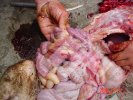Tuberculosis
Swine tuberculosis is rare today, but the most common is the Mycobacterium avium complex. Its importance lies in the fact that it causes nodules in the lymph nodes in the neck that result in the confiscation of carcasses in the slaughterhouse.
Alternative names: TB, Mycobacterium tuberculosis, Mycobacterium avium, Mycobacterium bovis
Information
Tuberculosis affects mammals, including humans and birds. The causative organism, Mycobacterium tuberculosis, is subclassified into several types: human, bovine, and avian. The avian type is called M. avium (or M. avium complex) which affects mainly birds, but is also found in the environment. Pigs rarely become infected with the human types (M. tuberculosis) or bovine (M. bovis) but are often infected with M. avium complex.
The complex also causes non-progressive, sub-clinical illnesses in healthy people. The main concern is that it could cause serious illness in inmunodepressed people. If lesions in the neck are seen in the slaughterhouse, in most countries the head is confiscated and if lesions are found in the mesenteric lymph nodes that drain into the intestines, the viscera are confiscated. If the disease is more widespread in the body, which is rare, the whole carcass will be confiscated. If the small lesions are not detected during inspection, normal cooking of pork in the kitchen destroys the organism.
Symptoms
All ages
- It causes small lumps in the lymph nodes of the neck and those that drain into the small intestine.
- In the vast majority of cases the lesions are not progressive, they do not spread throughout the body, nor do they cause the pig to get sick. They are not excreted.
- There are no clinical signs and no difference in production between infected and uninfected pigs.
Causes / Contributing Factors
- The disease is not transmitted between pigs and it is considered an environmental infection. It is rarely diagnosed in live pigs.
- Fields that have been treated with chicken manure up to a year prior (or, in the case of bovine tuberculosis, fields with infected cattle or badgers).
- Avian tuberculosis, as its name suggests, is found in wild birds. The organism is excreted in large quantities in their excrement and therefore feed, grain, water and bedding contaminated by birds, are potential sources of disease.
- Water contaminated with M. avium is a common source of contamination.
Diagnosis
- In live pigs the diagnosis is based on the tuberculin skin test, but usually the producer realizes that the disease is present on his farm when he receives the list of the percentage of seizures in the slaughterhouse.
Control/Prevention
- There is no treatment.
- Eliminate contaminated feed and bedding.
- Prevent birds from accessing pig areas.
- Use water chlorination.
Atlas of pathology
See images in the Altlas related to Tuberculosis






